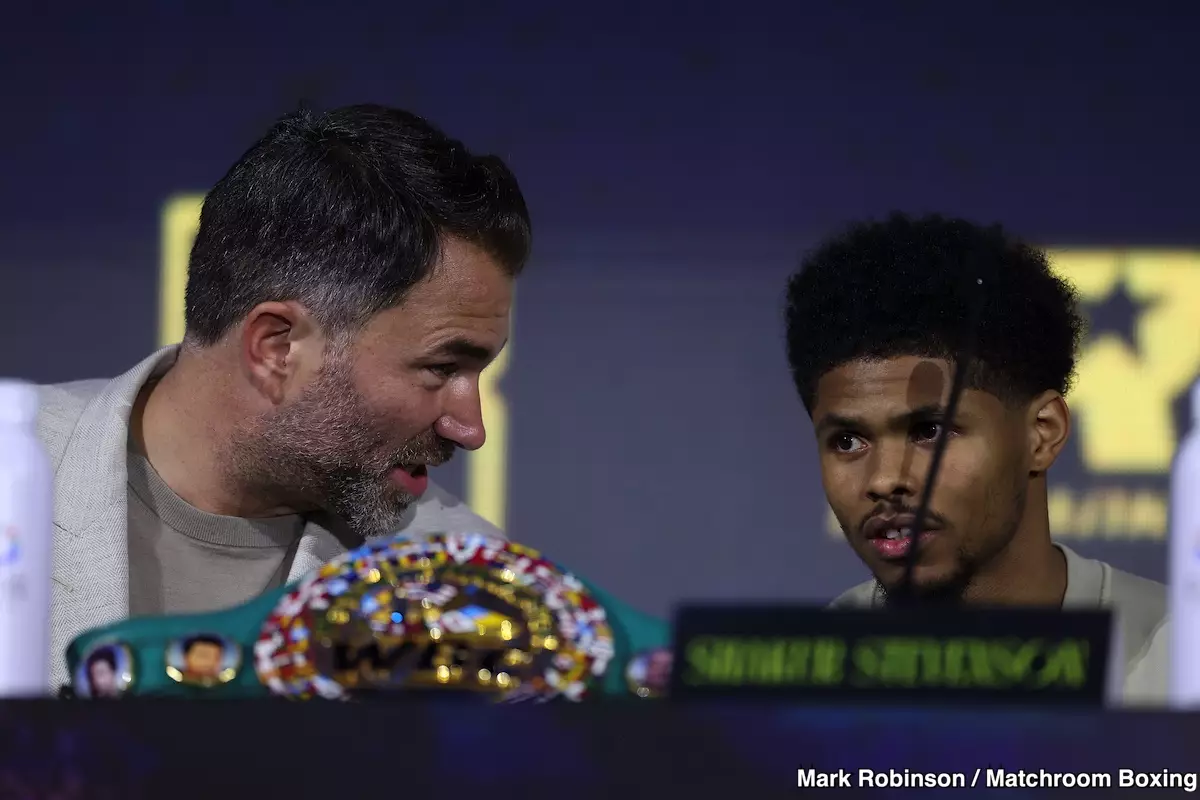In the realm of boxing, comparisons to legendary fighters often evoke both admiration and skepticism. Recently, promoter Eddie Hearn drew parallels between rising star Shakur Stevenson and the iconic Sugar Ray Leonard during a press conference promoting Stevenson’s bout against Josh Padley in Riyadh. While Hearn’s effusive praise aims to elevate Stevenson’s profile, it opens the floor for critical discussion about what such comparisons really entail and whether they hold any merit given Stevenson’s current status.
Sugar Ray Leonard is synonymous with boxing greatness. With a stellar career that showcased unmatched technical skill and charisma, Leonard fought and defeated many of the sport’s all-time greats. By the time he was 27, he had already faced and triumphed over the likes of Roberto Duran and Tommy Hearns—rivals that solidified his status in boxing history. Leonard’s accomplishments were not merely confined to titles; his ability to engage audiences and elevate the sport contributed to the monumental financial success he achieved, making him one of the highest-earning boxers of his time.
In contrast, Shakur Stevenson, at age 27 with a record of 22-0 and 10 knockouts, is still largely seen as a belt holder rather than a bona fide legacy maker. The references made by Hearn to Stevenson’s potential and his three-division championship status may seem impressive at a glance, but they ultimately fall short of the monumental achievements that Leonard amassed by the same age.
One of the key factors that differentiate Leonard from Stevenson is their fighting styles and ability to generate excitement in the ring. Leonard was known for his aggressive yet clever boxing style that combined speed, power, and showmanship. Fans and critics alike could hardly look away from his bouts, as they were filled with suspense and fervor. On the other hand, while Stevenson has displayed deft defense and technical proficiency, critics argue that his fights tend to lack the same excitement and flair—leading to a more subdued reception among boxing aficionados.
Moreover, Leonard’s willingness to chase the toughest opponents and move through weight classes contrasts sharply with Stevenson’s recent track of fighting lesser-known opponents, such as Padley, particularly after a last-minute opponent change. The question arises—if Stevenson is indeed the successor to Leonard, why is he not actively seeking matchups against more established or higher-caliber fighters?
Promoter Eddie Hearn’s comparison naturally raises expectations for Stevenson that he may not yet be equipped to meet. By putting Stevenson in the same conversation as legends like Leonard, Pernell Whitaker, and Floyd Mayweather, Hearn may inadvertently set Stevenson up for potential disappointment should his career trajectory fail to mirror those greats. Boxing, a sport not just of skill but also of timing and opportunity, presents many unpredictable variables. Stevenson may very well possess the ability to climb to greater heights, but invoking historical parallels can elevate the pressure to an unnecessary level.
As Stevenson prepares to defend his WBC lightweight title against Padley, it’s essential to remember that legacy is built over time and through competition against formidable opponents. Rushed comparisons can sometimes detract from the actual progression of a fighter’s career, rather than aid in its elevation.
With his 28th birthday approaching, time is of the essence for Stevenson to turn potential into legacy. The boxing world is rife with examples of fighters who emerged as greats but faltered when faced with opportunities to transcend mediocrity. By focusing on creating compelling matchups and challenging himself against stronger opposition, Stevenson has the chance to begin crafting a narrative that justifies Hearn’s high expectations.
While Eddie Hearn’s enthusiasm for Shakur Stevenson is commendable, the suggestion that he is the modern-day equivalent of Sugar Ray Leonard may well be premature. It is crucial for both fans and pundits to temper their expectations and understand that each fighter has a unique path, often requiring determination, willingness, and the right opportunities to define their legacy. The boxing community will eagerly await Stevenson’s next moves—not merely to see if he can live up to the hype, but to witness how he will forge his own identity in an already storied sport.

